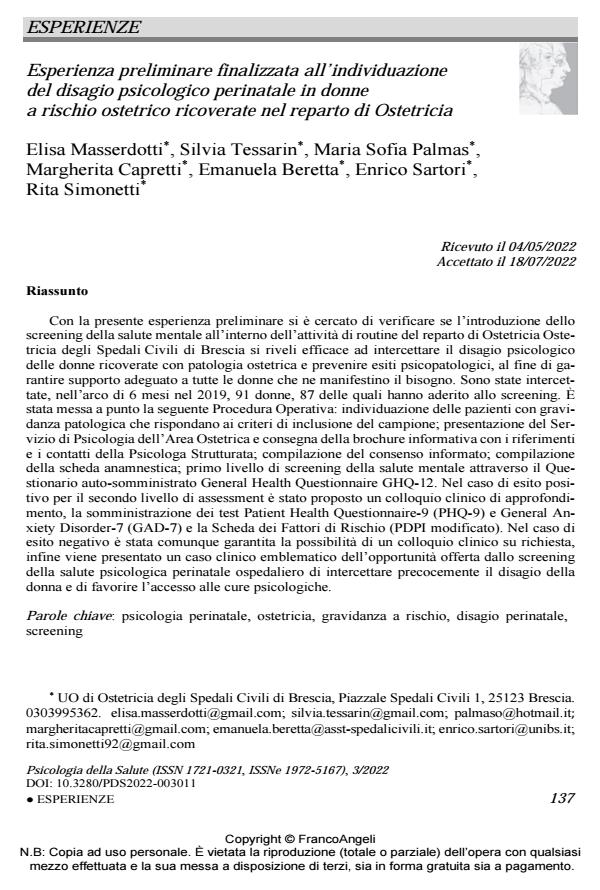Preliminary experience aimed at identifying perinatal psychological discomfort in women at risk of obstetrics hospitalized in the department of Obstetrics
Journal title PSICOLOGIA DELLA SALUTE
Author/s Elisa Masserdotti, Silvia Tessarin, Maria Sofia Palmas, Margherita Capretti, Emanuela Beretta, Enrico Sartori, Rita Simonetti
Publishing Year 2022 Issue 2022/3
Language Italian Pages 17 P. 137-153 File size 269 KB
DOI 10.3280/PDS2022-003011
DOI is like a bar code for intellectual property: to have more infomation
click here
Below, you can see the article first page
If you want to buy this article in PDF format, you can do it, following the instructions to buy download credits

FrancoAngeli is member of Publishers International Linking Association, Inc (PILA), a not-for-profit association which run the CrossRef service enabling links to and from online scholarly content.
Through the following preliminary experience, we have tried to verify if the introduction of the mental health screening in the ***** obstetrics department proves to be effective in detecting the psychological discomfort of hospitalised women with obstetrical pathology. We have also tried to confirm its usefulness in preventing psychopathological outcomes. For this experiment, which aims at ensuring an adequate support for all women in need, 91 subjects were intercepted over 6 months in 2019 and 87 of them joined the screening programme. The following Operational Procedure was developed: identification of patients with pathological pregnancy who met the criteria for inclusion of the sample; presentation of the Department of Obstetric Psychology and delivery of the information brochure with refer-ences and contacts of the Structured Psychologist; filling of the informed consent; filling of the anamnestic form; first level of mental health screening through the General Health Ques-tionnaire (GENERAL HEALTH QUESTIONNAIRE GHQ-12), a self-administered ques-tionnaire. In case of positive result, a clinical in-depth interview was proposed for the second level of assessment, in addition to the administration of Patient Health Questionnaire-9 (PA-TIENT HEALTH QUESTIONNAIRE-9 (PHQ-9)) and General Anxiety Disorder-7 (GENERAL ANXIETY DISORDER-7 (GAD-7)) tests and the Risk Factors Sheet (modi-fied PDPI). In case of negative result, the possibility of a clinic meeting on request was nev-ertheless guaranteed. Finally, we present an emblematic clinical case to show how a hospital perinatal psychological health screening can allow us to detect women’s discomfort in advance, hopefully resulting in a fostering access to the psychological treatment.
Keywords: perinatal psychology, obstetrics, pregnancy at risk, perinatal discomfort, screening
- Screening Hospitalized Pregnant Women and Their Male Partners for Possible Distress: A Comparison of the Clinical Usefulness of Two Screening Measures Anna Maria Della Vedova, Chiara Bani, Margherita Capretti, Silvia Lucariello, Rita Simonetti, Serena Pelamatti, Emanuela Beretta, in Behavioral Sciences /2025 pp.767
DOI: 10.3390/bs15060767
Elisa Masserdotti, Silvia Tessarin, Maria Sofia Palmas, Margherita Capretti, Emanuela Beretta, Enrico Sartori, Rita Simonetti, Esperienza preliminare finalizzata all’individuazione del disagio psicologico perinatale in donne a rischio ostetrico ricoverate nel reparto di Ostetricia in "PSICOLOGIA DELLA SALUTE" 3/2022, pp 137-153, DOI: 10.3280/PDS2022-003011